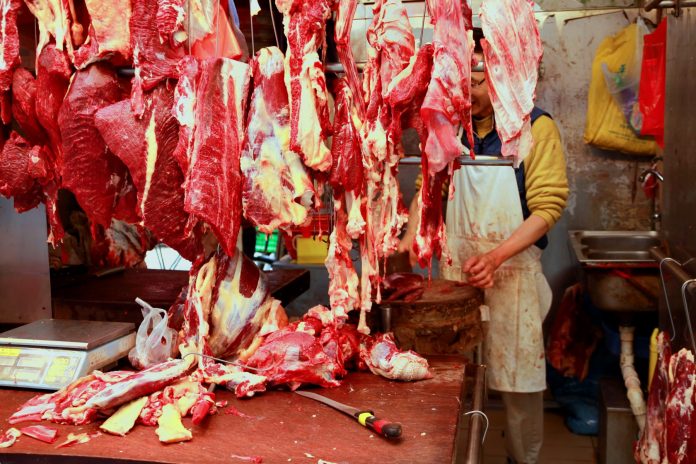
Eating less meat is crucial to counteracting climate change
Text Mangai Balasegaram
The Hong Kong government’s web page on climate change details its initiatives in this area and lists ways individuals can take action, such as recycling. At no point is there any mention of meat. And yet, the livestock sector accounts for a hefty 15 percent of global greenhouse gas (GHG) emissions – more than the emissions from all cars, planes, trains and ships combined – says the United Nation’s Food and Agricultural Organization.
Eating less beef offers an easy way to reduce one’s carbon footprint: One study showed producing one kilogram of beef represents driving a distance of about 160 kilometres.
Given that Hong Kong has the world’s highest meat – and beef – consumption per capita (significantly topping Australia, Argentina and the United States), the casual omission of cutting down meat on the government’s web page is significant. But it is not surprising. Many governments have avoided the issue and there is a paucity of related policies and plans.
Public awareness is poor. A 2014 worldwide survey by Ipsos MORI found twice as many people believed transport was a bigger contributor to global warming than livestock. A 2016 study from the Netherlands found that only 12 percent of the Dutch population and 6 percent of Americans were cognisant that cutting down meat could impact climate change.
Some experts say that the problem may be bigger than estimated. In 2009, Worldwatch Institute, a Washington DC-based think tank, released a report that estimated, controversially, that the livestock sector was tied to 51 percent of all GHGs.
“Agriculture in general has received much less attention in climate negotiations and among environmentalists, even though today’s heavily industrialised agriculture is a major GHG emitter,” says Worldwatch researcher Wanqing Zhou.
The reasons for this, she says, include a lack of understanding of agriculture’s emission sources and possible “political and economic resistance” to the issue. Another reason, say some environmentalists, is the fierce lobbying of the meat industry.

Rising demand
Global consumption of meat is forecast to grow 76 percent by 2050, says the British thinktank Chatham House. The nexus of this growth is Asia; a typical “nutrition transition” trend is expected amid rising incomes and a burgeoning population.
The Meat Atlas estimates 80 percent of the meat sector’s growth will be in Asia by 2022. What was once a treat a decade or so ago is now a staple part of many people’s diet.
In China, meat consumption is six times what it was in 1978, and is rising, says the WildAid report “Eating for Tomorrow”. Beef was once so rare that it was called “millionaire’s meat”. Now, the average Chinese person eats 63 kilograms of meat a year – about half as much as the average American. In total, China consumes a third of the world’s meat and half of all its pork.
Demand for meat is also set to rise in Indonesia, India and Vietnam. Chatham House ranks Indonesia as a top 10 nation for forecast meat consumption growth. The beef industry has its eyes on Vietnam.
Hong Kong has mega meat consumption levels, at 144 kilograms per person a year – about 430 grams a day. Australians also love their meat, eating more than Americans in 2014. In Malaysia, chicken consumption is among the highest worldwide.
Consumption in many industrialised countries has already plateaued at high levels, double – or even triple in the United States – what is considered “healthy” levels.
Left unchecked, such consumption levels are perilous. Agriculture will take up 87 percent of the world’s carbon budget for 2050, leaving little for the energy, industry and transport sectors. “Even under the most ambitious of decarbonisation scenarios, it will be near impossible for emissions from other sectors” to adjust accordingly, says the Chatham House report “Changing Climate, Changing Diet”.
An “obvious” solution to avoid “catastrophic” climate change (keeping temperature rise below the threshold safe level of two degrees celsius) is to cut meat consumption, says the report. Worldwide adoption of healthy meat consumption levels would generate over a quarter of the emission reductions needed by 2050.

China takes the lead
As much as the problem is growing in Asia, a solution is also emerging here. By sheer population size and rising demand, China will determine whether the world succeeds in mitigating climate change. And right now, it is taking the lead. It is advocating cutting meat consumption by 50 percent, which would result in 70 percent less emissions than the forecast for 2030.
The Chinese Communist Party has found unusual allies to support its nationwide campaign: Hollywood celebrities Arnold Schwarzenegger and James Cameron. They have worked with WildAid to produce campaign videos and billboards to run nationwide with the tagline: Less Meat, Less Heat, More Life. China’s move was a “massive leadership step” forwards, Cameron says.
In China, “the reaction we’ve got is overwhelmingly positive” to the campaign, says WildAid’s Matt Grager. He adds that surveys showed Chinese citizens were aware of the negative health effects of high meat consumption and were willing to cut consumption.
Chatham House also reported that surveys found people in China and Brazil more open to information and willing to change behaviour. By contrast, in the US and Japan, awareness, and willingness to change, was low.
In the absence of government initiatives, individuals have sometimes taken the lead. Paul McCartney’s “Meat Free Monday” campaign drew a host of celebrities, including Gwyneth Paltrow, Jamie Oliver and Sir Richard Branson.
In Hong Kong, David Yeung took up what he describes as a “David versus Goliath fight” when he first pushed the idea of a meatless meal on Monday. Today, his Green Monday organisation is familiar to about 30 percent of locals, surveys show. It has 1,000 restaurants and 800 schools offering vegetarian options on Monday. And it has other ventures, such as reducing waste from banquets.

The organisation’s Vivien Tse says about 22 percent of people in Hong Kong now eat a vegetarian meal once a week. But, she adds, the government needs to play “a more active role on policy”, by, for example, having a meat tax.
Singapore has also started “Green and Healthy Monday”, but many people are still unaware of the links with climate change, says the Vegetarian Society president George Jacobs.
The movement, regionally and globally is slow, but sure. Today, there is a byword for adopting a partial vegetarian diet: flexitarianism. In 2017, this may be one of the biggest food trends, according to the US chain Whole Foods.
For more stories and photographs from the issue, see Asian Geographic Issue 123, 2017










